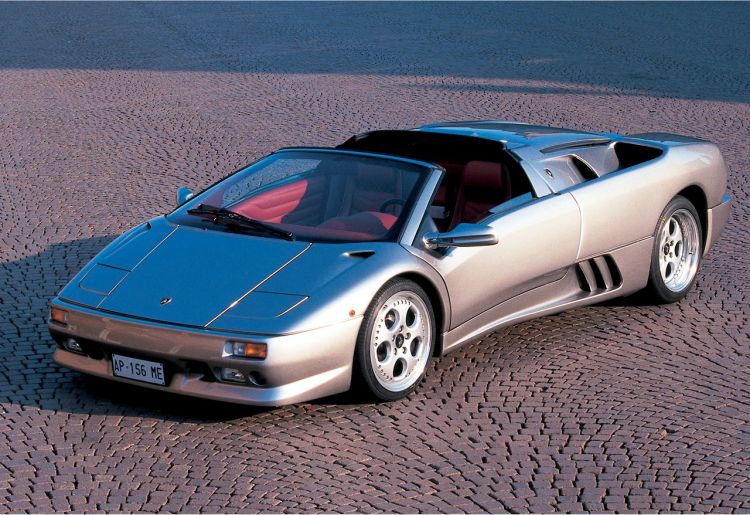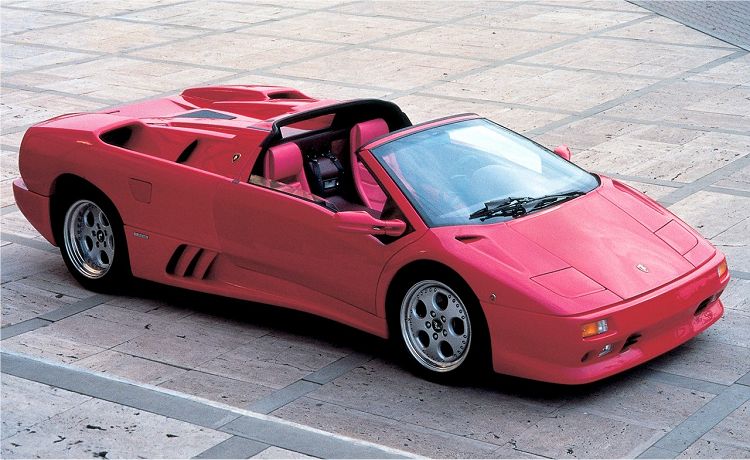Description
The Lamborghini Diablo VT Roadster, introduced in 1995, was the first open-top production car in Lamborghini’s history—a spectacular blend of brutal performance and dramatic design that captured the spirit of the brand at its most extroverted. It was the car that brought the Diablo’s ferocious character into the open air, allowing drivers to experience the full sound and fury of Lamborghini’s legendary V12 without a roof between them and the world. Combining the technological sophistication of the Diablo VT with new styling and aerodynamic refinements, the VT Roadster became one of the most desirable and visually arresting supercars of the 1990s.
The Diablo VT Roadster was developed from the all-wheel-drive Diablo VT (Viscous Traction), introduced two years earlier. The addition of all-wheel drive had already transformed the Diablo into a more composed and usable supercar, and the Roadster built upon that foundation with structural reinforcements and a removable carbon-fiber roof. The roof panel could be detached and stored over the engine cover, preserving the car’s aggressive silhouette even when open. This innovation allowed Lamborghini to offer the excitement of open-air motoring without compromising the car’s dramatic proportions or performance.
Power came from the familiar 5.7-litre V12 engine, displacing 5,707 cc and equipped with four valves per cylinder. In the VT Roadster, it produced 492 horsepower at 7,000 rpm and 580 Nm of torque at 5,200 rpm. Power was transmitted through a five-speed manual gearbox to all four wheels, with 27 percent of the torque directed to the front axle via a viscous coupling when rear-wheel slip was detected. This system, adapted from Lamborghini’s experience with the LM002 off-roader, gave the Roadster remarkable traction and stability for a car capable of exceeding 320 km/h (200 mph). The Roadster could accelerate from 0 to 100 km/h (62 mph) in around 4.1 seconds, matching the hardtop version’s staggering performance despite the additional weight from the roof structure.
The chassis was based on a tubular steel spaceframe with carbon-fiber and aluminium components to preserve rigidity. Lamborghini engineers reinforced the sills, floor, and windshield frame to compensate for the loss of a fixed roof, while recalibrating the suspension to maintain precise handling characteristics. The suspension featured unequal-length wishbones, coil springs, and Koni adjustable dampers, allowing drivers to tailor the car’s ride and response. Ventilated disc brakes with four-piston calipers provided immense stopping power, and the wide Pirelli P Zero tyres—235/40 ZR17 at the front and 335/35 ZR17 at the rear—ensured massive grip.
Visually, the Diablo VT Roadster was a masterpiece of presence and proportion. The car’s shape retained the low, wide wedge design that had defined the Diablo since 1990 but incorporated several unique features. The front bumper and air intakes were subtly reshaped for better cooling and aerodynamic balance, while the rear deck was redesigned to accommodate the removable roof panel. The engine cover featured twin air scoops and a distinctive carbon-fiber finish that hinted at the power beneath. With the roof removed, the car took on an entirely new personality—more sculptural, more dramatic, and even more audacious than the coupe.
The interior reflected Lamborghini’s growing emphasis on comfort and craftsmanship during the 1990s. The cabin was trimmed in fine Italian leather with improved ergonomics and better sound insulation. The seats were wider and more supportive than in earlier models, the steering wheel was adjustable, and the climate control system was more effective. Despite its ferocious performance, the VT Roadster could be driven comfortably on long journeys, combining the excitement of a race-bred engine with surprising refinement. Yet the driving position remained low and commanding, the view forward dominated by the sweeping fenders and the long bonnet—a reminder that this was still a true Lamborghini at heart.
Driving the Diablo VT Roadster was an experience that combined visceral power with unexpected composure. The V12 engine roared to life with a deep, metallic bark, and the sensation of acceleration was amplified by the open cockpit, the sound reflecting off the bodywork and surrounding environment. The all-wheel-drive system gave the car tremendous grip and stability, particularly in corners or on imperfect surfaces, while the steering was weighty and direct. Despite its size and power, the Roadster felt balanced and controllable at high speed—a remarkable achievement for a car so visually and mechanically extreme.
Production of the Diablo VT Roadster continued until 1998, with approximately 200 examples built. Each car was hand-assembled at Sant’Agata Bolognese, and customers could choose from Lamborghini’s famously vibrant color palette, including Rosso Vik, Blu Scuro, Verde Scandal, and Giallo Orion. The Roadster’s combination of performance, craftsmanship, and visual drama made it one of the most desirable Diablos and a milestone in Lamborghini’s history as the brand’s first open-top supercar.
Today, the Lamborghini Diablo VT Roadster remains one of the most iconic and collectible Diablos ever made. It represents the perfect intersection between the analog intensity of the early Diablos and the luxury-focused refinement that would define Lamborghini’s later models. The combination of a screaming V12, open-air freedom, and timeless design ensures that the VT Roadster stands as a symbol of unrestrained automotive passion—a car that embodied everything Lamborghini stood for at the close of the 20th century: power, beauty, and the art of excess.

